定冠词the的用法
- 格式:doc
- 大小:163.00 KB
- 文档页数:12
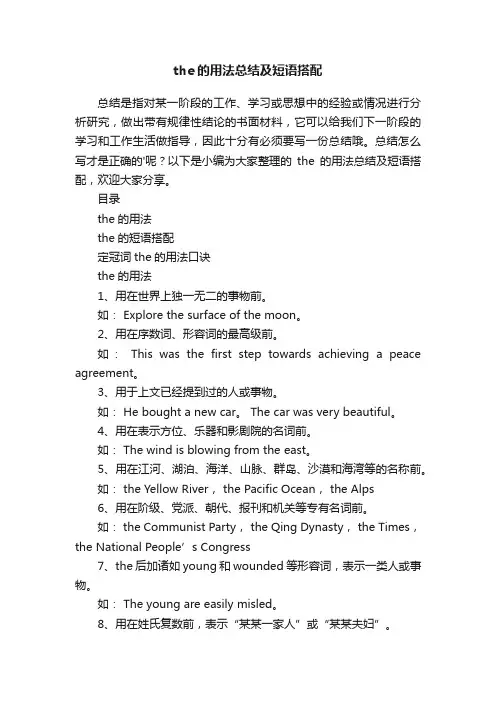
the的用法总结及短语搭配总结是指对某一阶段的工作、学习或思想中的经验或情况进行分析研究,做出带有规律性结论的书面材料,它可以给我们下一阶段的学习和工作生活做指导,因此十分有必须要写一份总结哦。
总结怎么写才是正确的'呢?以下是小编为大家整理的the的用法总结及短语搭配,欢迎大家分享。
目录the的用法the的短语搭配定冠词the的用法口诀the的用法1、用在世界上独一无二的事物前。
如: Explore the surface of the moon。
2、用在序数词、形容词的最高级前。
如:This was the first step towards achieving a peace agreement。
3、用于上文已经提到过的人或事物。
如: He bought a new car。
The car was very beautiful。
4、用在表示方位、乐器和影剧院的名词前。
如: The wind is blowing from the east。
5、用在江河、湖泊、海洋、山脉、群岛、沙漠和海湾等的名称前。
如: the Yellow River, the Pacific Ocean, the Alps6、用在阶级、党派、朝代、报刊和机关等专有名词前。
如: the Communist Party, the Qing Dynasty, the Times,the National People’s Congress7、the后加诸如young和wounded等形容词,表示一类人或事物。
如: The young are easily misled。
8、用在姓氏复数前,表示“某某一家人”或“某某夫妇”。
如: the Smiths9、用在双方都知道的事物前。
如:The bag on the desk isn’t mine。
10、表示“击打”的动词常用于“动词+宾语+介词+ the +被击打的部位”结构中。
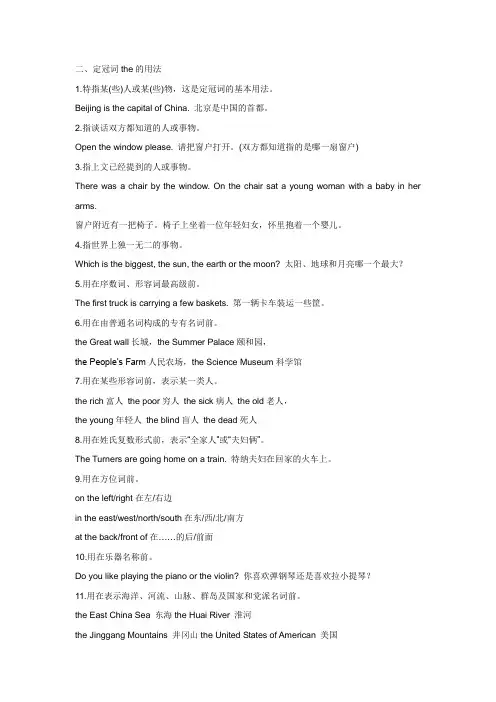
二、定冠词the的用法1.特指某(些)人或某(些)物,这是定冠词的基本用法。
Beijing is the capital of China. 北京是中国的首都。
2.指谈话双方都知道的人或事物。
Open the window please. 请把窗户打开。
(双方都知道指的是哪一扇窗户)3.指上文已经提到的人或事物。
There was a chair by the window. On the chair sat a young woman with a baby in her arms.窗户附近有一把椅子。
椅子上坐着一位年轻妇女,怀里抱着一个婴儿。
4.指世界上独一无二的事物。
Which is the biggest, the sun, the earth or the moon? 太阳、地球和月亮哪一个最大?5.用在序数词、形容词最高级前。
The first truck is carrying a few baskets. 第一辆卡车装运一些筐。
6.用在由普通名词构成的专有名词前。
the Great wall长城,the Summer Palace颐和园,the People’s Farm人民农场,the Science Museum科学馆7.用在某些形容词前,表示某一类人。
the rich富人the poor穷人the sick病人the old老人,the young年轻人the blind盲人the dead死人8.用在姓氏复数形式前,表示“全家人”或“夫妇俩”。
The Turners are going home on a train. 特纳夫妇在回家的火车上。
9.用在方位词前。
on the left/right在左/右边in the east/west/north/south在东/西/北/南方at the back/front of在……的后/前面10.用在乐器名称前。
Do you like playing the piano or the violin? 你喜欢弹钢琴还是喜欢拉小提琴?11.用在表示海洋、河流、山脉、群岛及国家和党派名词前。
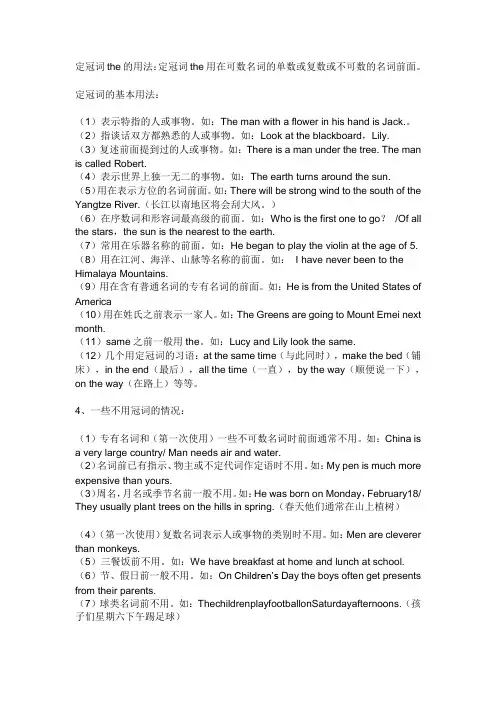
定冠词the的用法:定冠词the用在可数名词的单数或复数或不可数的名词前面。
定冠词的基本用法:(1)表示特指的人或事物。
如:The man with a flower in his hand is Jack.。
(2)指谈话双方都熟悉的人或事物。
如:Look at the blackboard,Lily.(3)复述前面提到过的人或事物。
如:There is a man under the tree. The man is called Robert.(4)表示世界上独一无二的事物。
如:The earth turns around the sun.(5)用在表示方位的名词前面。
如:There will be strong wind to the south of the Yangtze River.(长江以南地区将会刮大风。
)(6)在序数词和形容词最高级的前面。
如:Who is the first one to go?/Of all the stars,the sun is the nearest to the earth.(7)常用在乐器名称的前面。
如:He began to play the violin at the age of 5.(8)用在江河、海洋、山脉等名称的前面。
如:I have never been to the Himalaya Mountains.(9)用在含有普通名词的专有名词的前面。
如:He is from the United States of America(10)用在姓氏之前表示一家人。
如:The Greens are going to Mount Emei next month.(11)same之前一般用the。
如:Lucy and Lily look the same.(12)几个用定冠词的习语:at the same time(与此同时),make the bed(铺床),in the end(最后),all the time(一直),by the way(顺便说一下),on the way(在路上)等等。
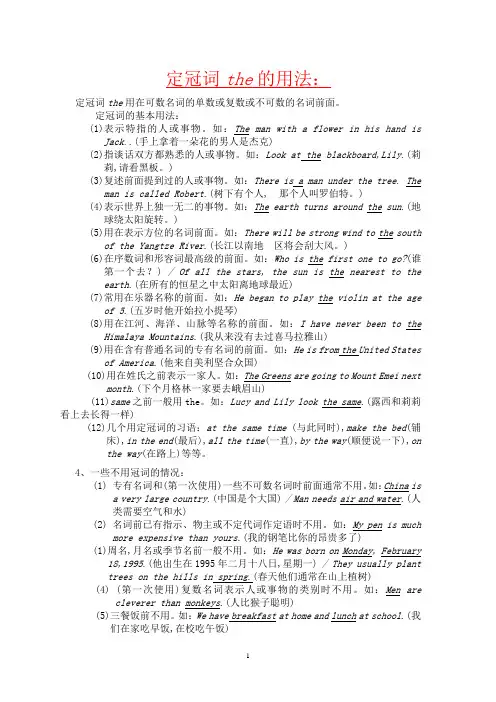
定冠词the的用法:定冠词the用在可数名词的单数或复数或不可数的名词前面。
定冠词的基本用法:(1)表示特指的人或事物。
如:The man with a flower in his hand isJack..(手上拿着一朵花的男人是杰克)(2)指谈话双方都熟悉的人或事物。
如:Look at the blackboard,Lily.(莉莉,请看黑板。
)(3)复述前面提到过的人或事物。
如:There is a man under the tree. Theman is called Robert.(树下有个人, 那个人叫罗伯特。
)(4)表示世界上独一无二的事物。
如:The earth turns around the sun.(地球绕太阳旋转。
)(5)用在表示方位的名词前面。
如:There will be strong wind to the southof the Yangtze River.(长江以南地区将会刮大风。
)(6)在序数词和形容词最高级的前面。
如:Who is the first one to go?(谁第一个去?) / Of all the stars, the sun is the nearest to theearth.(在所有的恒星之中太阳离地球最近)(7)常用在乐器名称的前面。
如:He began to play the violin at the ageof 5.(五岁时他开始拉小提琴)(8)用在江河、海洋、山脉等名称的前面。
如:I have never been to theHimalaya Mountains.(我从来没有去过喜马拉雅山)(9)用在含有普通名词的专有名词的前面。
如:He is from the United Statesof America.(他来自美利坚合众国)(10)用在姓氏之前表示一家人。
如:The Greens are going to Mount Emei nextmonth.(下个月格林一家要去峨眉山)(11)same之前一般用the。
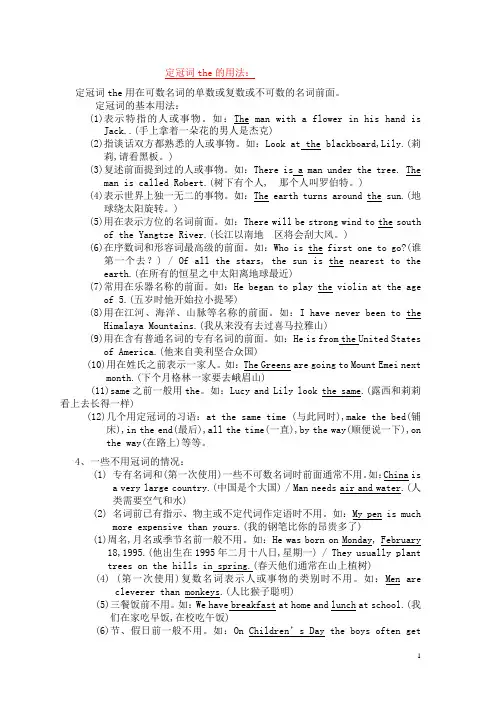
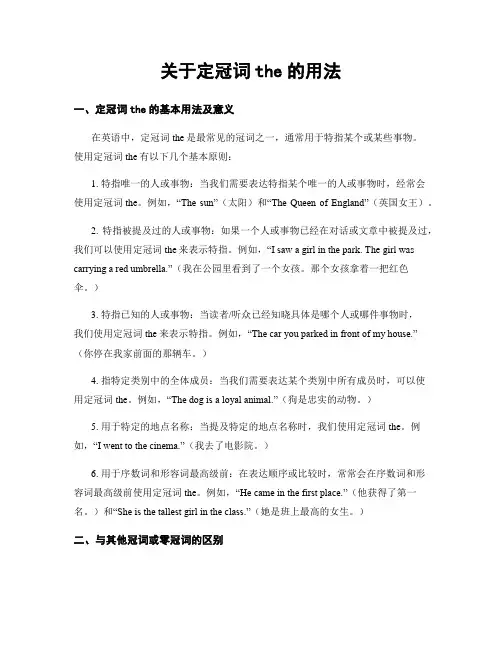
关于定冠词the的用法一、定冠词the的基本用法及意义在英语中,定冠词the是最常见的冠词之一,通常用于特指某个或某些事物。
使用定冠词the有以下几个基本原则:1. 特指唯一的人或事物:当我们需要表达特指某个唯一的人或事物时,经常会使用定冠词the。
例如,“The sun”(太阳)和“The Queen of England”(英国女王)。
2. 特指被提及过的人或事物:如果一个人或事物已经在对话或文章中被提及过,我们可以使用定冠词the来表示特指。
例如,“I saw a girl in the park. The girl was carrying a red umbrella.”(我在公园里看到了一个女孩。
那个女孩拿着一把红色伞。
)3. 特指已知的人或事物:当读者/听众已经知晓具体是哪个人或哪件事物时,我们使用定冠词the来表示特指。
例如,“The car you parked in front of my house.”(你停在我家前面的那辆车。
)4. 指特定类别中的全体成员:当我们需要表达某个类别中所有成员时,可以使用定冠词the。
例如,“The dog is a loyal animal.”(狗是忠实的动物。
)5. 用于特定的地点名称:当提及特定的地点名称时,我们使用定冠词the。
例如,“I went to the cinema.”(我去了电影院。
)6. 用于序数词和形容词最高级前:在表达顺序或比较时,常常会在序数词和形容词最高级前使用定冠词the。
例如,“He came in the first place.”(他获得了第一名。
)和“She is the tallest girl in the class.”(她是班上最高的女生。
)二、与其他冠词或零冠词的区别除了定冠词the外,英语中还有不定冠词a/an以及零冠词(即没有任何冠词)。
这些冠词用法与定冠词the有所不同。
1. 不定冠词a/an:不定冠词用于泛指或表示数量不确定的人或事物。
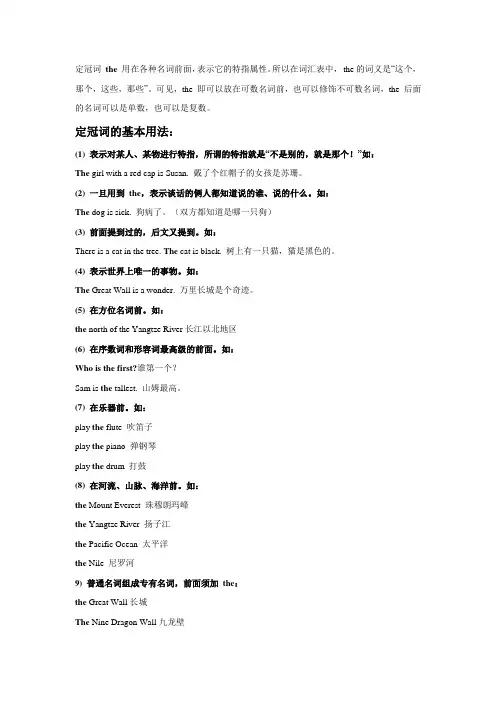
定冠词the 用在各种名词前面,表示它的特指属性。
所以在词汇表中,the的词义是“这个,那个,这些,那些”。
可见,the 即可以放在可数名词前,也可以修饰不可数名词,the 后面的名词可以是单数,也可以是复数。
定冠词的基本用法:(1) 表示对某人、某物进行特指,所谓的特指就是“不是别的,就是那个!”如:The girl with a red cap is Susan. 戴了个红帽子的女孩是苏珊。
(2) 一旦用到the,表示谈话的俩人都知道说的谁、说的什么。
如:The dog is sick. 狗病了。
(双方都知道是哪一只狗)(3) 前面提到过的,后文又提到。
如:There is a cat in the tree. The cat is black. 树上有一只猫,猫是黑色的。
(4) 表示世界上唯一的事物。
如:The Great Wall is a wonder. 万里长城是个奇迹。
(5) 在方位名词前。
如:the north of the Yangtze River长江以北地区(6) 在序数词和形容词最高级的前面。
如:Who is the first?谁第一个?Sam is the tallest. 山姆最高。
(7) 在乐器前。
如:play the flute 吹笛子play the piano 弹钢琴play the drum 打鼓(8) 在河流、山脉、海洋前。
如:the Mount Everest 珠穆朗玛峰the Yangtze River 扬子江the Pacific Ocean 太平洋the Nile 尼罗河9) 普通名词组成专有名词,前面须加the:the Great Wall长城The Nine Dragon Wall九龙壁(10) the加姓氏的复数,表示一家人。
如:the Sawyers 索耶一家人the Lees 姓李的一家人(11) same 前要用theWe are twins, but we don't look the same. 我们俩是双胞胎,看着却不一样。
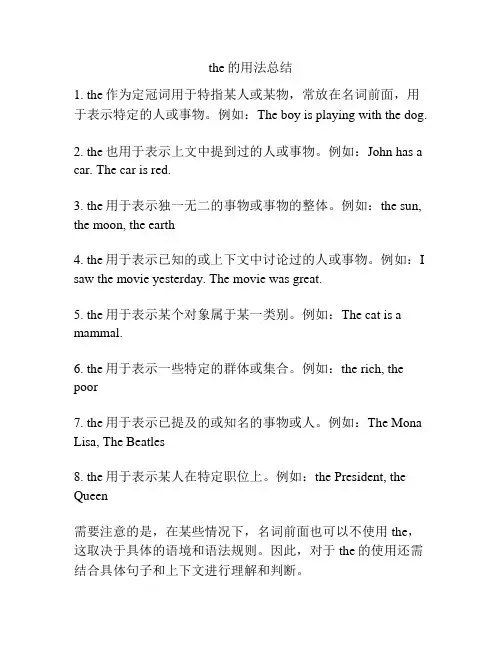
the的用法总结
1. the作为定冠词用于特指某人或某物,常放在名词前面,用于表示特定的人或事物。
例如:The boy is playing with the dog.
2. the也用于表示上文中提到过的人或事物。
例如:John has a car. The car is red.
3. the用于表示独一无二的事物或事物的整体。
例如:the sun, the moon, the earth
4. the用于表示已知的或上下文中讨论过的人或事物。
例如:I saw the movie yesterday. The movie was great.
5. the用于表示某个对象属于某一类别。
例如:The cat is a mammal.
6. the用于表示一些特定的群体或集合。
例如:the rich, the poor
7. the用于表示已提及的或知名的事物或人。
例如:The Mona Lisa, The Beatles
8. the用于表示某人在特定职位上。
例如:the President, the Queen
需要注意的是,在某些情况下,名词前面也可以不使用the,这取决于具体的语境和语法规则。
因此,对于the的使用还需结合具体句子和上下文进行理解和判断。
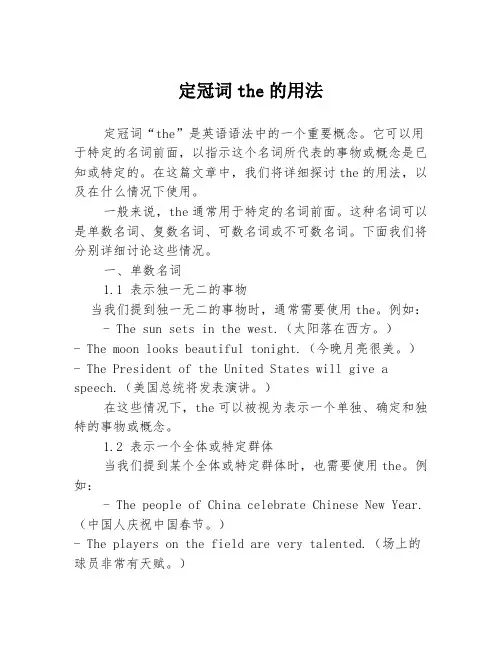
定冠词the的用法定冠词“the”是英语语法中的一个重要概念。
它可以用于特定的名词前面,以指示这个名词所代表的事物或概念是已知或特定的。
在这篇文章中,我们将详细探讨the的用法,以及在什么情况下使用。
一般来说,the通常用于特定的名词前面。
这种名词可以是单数名词、复数名词、可数名词或不可数名词。
下面我们将分别详细讨论这些情况。
一、单数名词1.1 表示独一无二的事物当我们提到独一无二的事物时,通常需要使用the。
例如:- The sun sets in the west.(太阳落在西方。
)- The moon looks beautiful tonight.(今晚月亮很美。
)- The President of the United States will give a speech.(美国总统将发表演讲。
)在这些情况下,the可以被视为表示一个单独、确定和独特的事物或概念。
1.2 表示一个全体或特定群体当我们提到某个全体或特定群体时,也需要使用the。
例如:- The people of China celebrate Chinese New Year.(中国人庆祝中国春节。
)- The players on the field are very talented.(场上的球员非常有天赋。
)- The students in my class are very intelligent.(我班上的学生非常聪明。
)在这种情况下,the表示一个特定的集体或整体。
1.3 表示某个地方或场所当我们提到某个特定的地方或场所时,也需要使用the。
例如:- I'm going to the grocery store.(我要去杂货店。
)- The library is open until 10 pm tonight.(图书馆今晚开放到晚上10点。
)- Let's go to the park.(我们去公园吧。
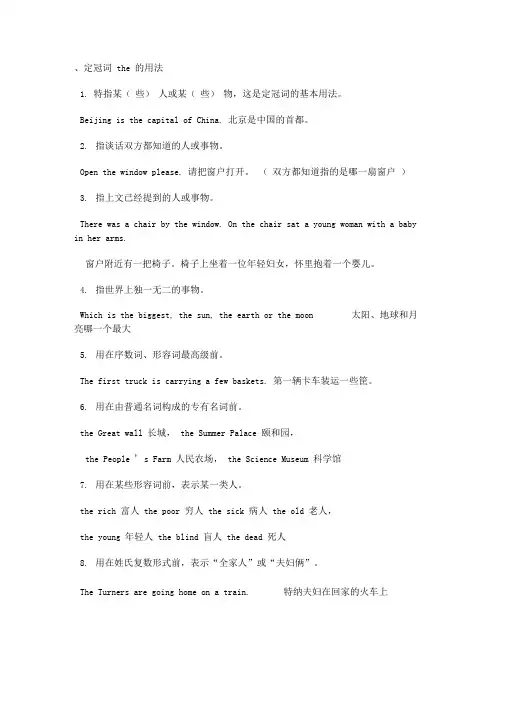
、定冠词the 的用法1. 特指某(些)人或某(些)物,这是定冠词的基本用法。
Beijing is the capital of China. 北京是中国的首都。
2.指谈话双方都知道的人或事物。
Open the window please. 请把窗户打开。
(双方都知道指的是哪一扇窗户)3.指上文已经提到的人或事物。
There was a chair by the window. On the chair sat a young woman with a baby in her arms.窗户附近有一把椅子。
椅子上坐着一位年轻妇女,怀里抱着一个婴儿。
4.指世界上独一无二的事物。
Which is the biggest, the sun, the earth or the moon 太阳、地球和月亮哪一个最大5.用在序数词、形容词最高级前。
The first truck is carrying a few baskets. 第一辆卡车装运一些筐。
6.用在由普通名词构成的专有名词前。
the Great wall 长城,the Summer Palace 颐和园,the People ' s Farm 人民农场,the Science Museum 科学馆7.用在某些形容词前,表示某一类人。
the rich 富人the poor 穷人the sick 病人the old 老人,the young 年轻人the blind 盲人the dead 死人8.用在姓氏复数形式前,表示“全家人”或“夫妇俩”。
The Turners are going home on a train.特纳夫妇在回家的火车上9. 用在方位词前。
10. 用在乐器名称前。
Do you like playing the piano or the violin 提琴 11. 用在表示海洋、河流、山脉、群岛及国家和党派名词前。
the East China Sea 东海 the Huai River 淮河the Jinggang Mountains 井冈山 the United States of American 美国12. 用在某些固定词组中。
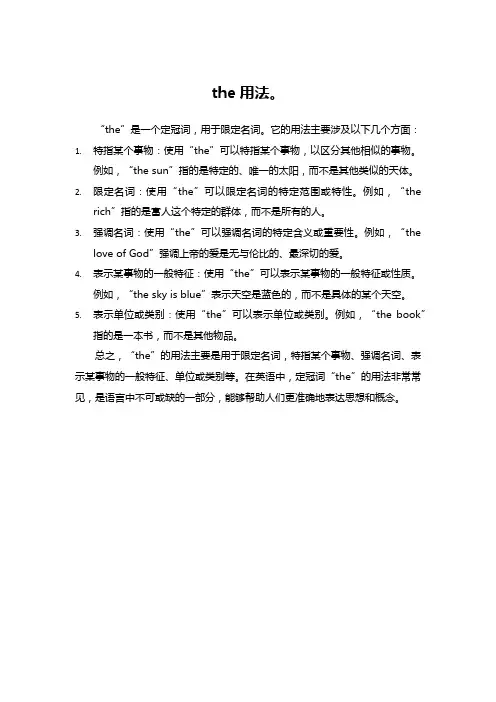
the用法。
“the”是一个定冠词,用于限定名词。
它的用法主要涉及以下几个方面:1.特指某个事物:使用“the”可以特指某个事物,以区分其他相似的事物。
例如,“the sun”指的是特定的、唯一的太阳,而不是其他类似的天体。
2.限定名词:使用“the”可以限定名词的特定范围或特性。
例如,“the
rich”指的是富人这个特定的群体,而不是所有的人。
3.强调名词:使用“the”可以强调名词的特定含义或重要性。
例如,“the
love of God”强调上帝的爱是无与伦比的、最深切的爱。
4.表示某事物的一般特征:使用“the”可以表示某事物的一般特征或性质。
例如,“the sky is blue”表示天空是蓝色的,而不是具体的某个天空。
5.表示单位或类别:使用“the”可以表示单位或类别。
例如,“the book”
指的是一本书,而不是其他物品。
总之,“the”的用法主要是用于限定名词,特指某个事物、强调名词、表示某事物的一般特征、单位或类别等。
在英语中,定冠词“the”的用法非常常见,是语言中不可或缺的一部分,能够帮助人们更准确地表达思想和概念。
定冠词the 的用法
1、表示“特定的”的人或物。
有特定指称的对象时,前面要加定冠词the,以表示“指定”。
2、表示双方都知道的或心中明白的人或物。
3、第二次提到时要用定冠词the(第一次提到时用不定冠词a或an)。
4、用在世界上独一无二的名词前,表示“唯一”。
5、用在表示方向、方位的名词前。
例:
The birds are flying to the north、
这些鸟正向北方飞去。
6、用在形容词最高级前,表示“最……”。
7、用在序数词前,表示“第……”。
the用在专有名词之前。
有“专属名称”的自然景观,如河流、山脉、群岛、海洋或建筑物等,前面这会加上定冠词the。
定冠词the的12种用法定冠词the 的12 种用法,全知道?快来一起学习吧。
下面就和大家分享,来欣赏一下吧。
定冠词the 的12 种用法,全知道?定冠词the用在各种名词前面,目的是对这个名词做个记号,表示它的特指属性。
所以在词汇表中,定冠词the 的词义是“这个,那个,这些,那些”,可见,the 即可以放在可数名词前,也可以修饰不可数名词,the 后面的名词可以是单数,也可以是复数。
定冠词的基本用法:(1) 表示对某人、某物进行特指,所谓的特指就是“不是别的,就是那个!”如:The girl with a red cap is Susan.戴了个红帽子的女孩是苏珊。
(2) 一旦用到the,表示谈话的俩人都知道说的谁、说的啥。
如:The dog is sick. 狗狗病了。
(双方都知道是哪一只狗) (3) 前面提到过的,后文又提到。
如:There is a cat in the tree.Thecat is black.树上有一只猫,猫是黑色的。
(4) 表示世界上唯一的事物。
如:The Great Wall is a wonder.万里长城是个奇迹。
(5) 方位名词前。
如:thenorth of the Yangtze River长江以北地区(6) 在序数词和形容词最高级的前面。
如:Who is the first?谁第一个?Sam is the tallest.山姆最高。
但是不能认为,最高级前必须加the,如:My best friend. 我最好的朋友。
(7) 在乐器前。
如:play the flute 吹笛子play the piano 弹钢琴play the drum 打鼓(8) 河流、山脉、海洋前。
如:the Mount Everest 珠穆朗玛峰the Yangtze River 扬子江the Pacific Ocean 太平洋the Nile 尼罗河(9) 普通名词组成专有名词,前面须加the:theGreat Wall长城theNine Dragon Wall九龙壁(10) the 加姓氏的复数,表示一家人。
The 的用法归纳1 表示特指的人或物例: Please hand me the key on the desk. 请把桌上的钥匙递给我。
The girl in redis his sister. 穿红色衣服的女孩是他妹妹。
The building over there is the tallest in the town. 那边那幢大楼是这个城里最高的。
I like the music of the film. 我喜欢这部电影的音乐。
2 表示双方都知道的或心中明白的人或物例: Shut the door, please. 请关门。
Has he returned the book? 那本书他还了吗?Take the blue one, it is cheaper. 拿那个蓝的,它便宜些。
3 第二次提到某人或某物第一次提到时用不定冠词,第二次提到时要用定冠词。
例: He saw a house in the distance. Jim's parents lived in the house. 他看见远处有一所房子,吉姆的父母就住在那所房子里。
There was once an old fisherman. The old fisherman had a cat. The cat was white. 从前有一个老渔夫。
这个老渔夫有一只猫。
这只猫是只白猫。
4 用在世界上独一无二的名词前这类词有:the sun 太阳, the earth 地球, the moon 月亮, the sky 天空, the world 世界例: The moon goes round the earth. 月亮绕着地球转。
There is not any cloud in the sky. 天空中没有一丝云彩。
It was a fine day in spring. The sun shone brightly. 这是一个晴朗的春日,阳光灿烂。
定冠词the的九种常见用法定冠词“the”在英语中属于基础但却又常被误用的语法元素,正确的使用“the”可以使句子更具表达力和准确性。
下面我们将探讨关于定冠词“the”的九种最常见用法,希望能够帮助大家更好地理解并正确运用这一语法规则。
首先,第一种常见用法是用于特指某一特定事物或概念。
比如,“the sun is shining brightly”,这里的“the sun”指代特定的太阳;“the president of the United States”中的“the president”指的是特定的美国总统。
其次,定冠词“the”也可以用在复数名词前表示泛指,这是第二种常见用法。
例如,“I love to eat the fruits from that tree”中的“the fruits”指的是那棵树上的所有水果。
第三种常见用法是用在形容词最高级前。
比如,“he is the tallest boy in the class”,这里“the tallest”表示最高的,是一个特定的范围内的最高。
另外,第四种用法是指某些特定的习语或短语搭配,需要使用“the”。
例如,“take the bus”、“hit the hay”等表达中“the”是不可省略的。
第五种常见用法是在一些国家、地区、河流、山脉等的名词前加上“the”。
例如,“the Great Wall”、“the United Kingdom”等都是固定搭配。
第六种用法是用在某些乐器的名词前,比如“play the piano”、“learn the guitar”等表达中都需要用上“the”。
第七种用法是在复数名词表示整体概念时,也需要使用“the”。
例如,“the rich get richer and the poor get poorer”中的“the rich”和“the poor”表示整体概念。
接下来,第八种用法是用在序数词前表达特定顺序。
今天我们来学习定冠词“the”的用法,快来一起学习吧。
下面小编就和大家分享,来欣赏一下吧。
定冠词“the”的用法定冠词the与指示代词this,that同源,有“那(这)个”的意思,但较弱,可以和一个名词连用,来表示某个或某些特定的人或东西。
1)特指双方都明白的人或物:Take the medicine. 把药吃了。
2)上文提到过的人或事:He bought a house. I've been to the house.他买了幢房子。
我去过那幢房子。
3)指世上独一物二的事物:the sun, the sky, the moon, the earth4)单数名词连用表示一类事物,如:the dollar 美元; the fox 狐狸;或与形容词或分词连用,表示一类人:the rich 富人; the living 生者。
5)用在序数词和形容词最高级,及形容词only, very, same等前面:Where do you live? I live on the second floor.你住在哪?我住在二层。
That's the very thing I've been looking for.那正是我要找的东西。
6)与复数名词连用,指整个群体:They are the teachers of this school. (指全体教师)They are teachers of this school. (指部分教师)7)表示所有,相当于物主代词,用在表示身体部位的名词前:She caught me by the arm. 她抓住了我的手臂。
8)用在某些由普通名词构成的国家名称、机关团体、阶级、等专有名词前:the People's Republic of China 中华人民共和国the United States 美国9)用在表示乐器的名词之前: She plays the piano. 她会弹钢琴。
the 定冠词的用法定冠词,又称“the”,是英语中一个很常见的语法元素。
它的功能是表示在一定上下文中特定的人、物、事、地点等。
具体来说,定冠词主要有以下几个用法:一、表示特指当我们需要表示“那个、这个、那些、这些”的时候,我们就需要使用定冠词“the”。
例如:- The book on the table is mine.(桌子上的那本书是我的。
)- I met the man who stole my wallet.(我遇到了偷我的钱包的那个人。
)- The oranges in this box are juicy.(这个盒子里的那些橙子很多汁。
)二、表示独一无二的事物- The sun rises in the east and sets in the west.(太阳从东边升起,西边落下。
)- The moon is the Earth's only natural satellite.(月球是地球唯一的天然卫星。
)- The President of the United States has many responsibilities.(美国总统有许多责任。
)三、表示某个群体中的一部分四、表示特定的时间、日期、地点在表示特定的时间、日期、地点的时候,也需要使用定冠词“the”。
五、不使用定冠词不过,也有一些情况下我们不需要使用定冠词。
“a”和“an”用于表示泛指单数物品。
而在表示复数物品时则可以不使用冠词。
综上所述,定冠词是英语中非常重要的一个语法元素。
只有理解了它的用法,才能更加灵活的运用英语表达自己的想法和意见。
、定冠词the的用法1.特指某(些)人或某(些)物,这是定冠词的基本用法。
Beijing is the capital of China. 北京是中国的首都。
2.指谈话双方都知道的人或事物。
Open the window please. 请把窗户打开。
(双方都知道指的是哪一扇窗户)3.指上文已经提到的人或事物。
There was a chair by the window. On the chair sat a young woman with a baby in her arms.窗户附近有一把椅子。
椅子上坐着一位年轻妇女,怀里抱着一个婴儿。
4.指世界上独一无二的事物。
Which is the biggest, the sun, the earth or the moon? 太阳、地球和月亮哪一个最大?5.用在序数词、形容词最高级前。
The first truck is carrying a few baskets. 第一辆卡车装运一些筐。
6.用在由普通名词构成的专有名词前。
the Great wall长城,the Summer Palace颐和园,the People’s Farm人民农场,the Science Museum科学馆7.用在某些形容词前,表示某一类人。
the rich富人the poor穷人the sick病人the old老人,the young年轻人the blind盲人the dead死人8.用在姓氏复数形式前,表示“全家人”或“夫妇俩”。
The Turners are going home on a train. 特纳夫妇在回家的火车上。
9.用在方位词前。
on the left/right在左/右边in the east/west/north/south在东/西/北/南方at the back/front of在……的后/前面10.用在乐器名称前。
Do you like playing the piano or the violin? 你喜欢弹钢琴还是喜欢拉小提琴?11.用在表示海洋、河流、山脉、群岛及国家和党派名词前。
the East China Sea 东海the Huai River 淮河the Jinggang Mountains 井冈山the United States of American 美国12.用在某些固定词组中。
all the same 仍然all the time 一直all the year round 一年到头at the age of 在……岁时at the beginning of 起初; 开始at the end of 在……的尽头/末尾at the entrance of 在……门口at the foot of 在……脚下at the head of 在……的前面at the moment 此刻at the same time 同时by the side of 在……附近by the time 到时候by the way 顺便说catch the post 赶上邮班do the shopping/washing 买东西/洗衣服give...the message 捎口信给……go to the classroom 去教室in the end 最后;终于in the hat 戴帽子的in the middle of the day 中午in the morning/afternoon / evening 在上午/下午/晚上in the open air 在户外;在野外jump the queue 不按次序排队lead the way to 引路;指路look the same 看起来很像on the earth 在地球上tell the truth 说实话the day after tomorrow 后天the day before yesterday 前天the high jump 跳高the long jump 跳远the next day 第二天the next year下一年the people 人民the starting line起跑线三、不用冠词的情况1.在专有名词和不可数名词前。
I’m going to England next week for a holiday.下周我将要去英国度假。
2.可数名词前已有作定语的物主代词my, your, his, her等;指示代词this/ these, that/those; 不定代词some, any等及所有格限制时。
The letter is in her pocket. 信在她的衣袋里。
3.复数名词表示一类人或事物时。
My father and mother are teachers. 我的父亲和母亲是教师。
4.在星期、月份、季节、节日前。
The best time to come to China is in spring or autumn. 到中国来的最好时间是春季或秋季。
Today is Thursday, September 10th, Teacher’s Day. 今天是九月十日,星期四,教师节。
[注意] 如果月份、季节等被一个限定性定语修饰,则要加定冠词。
He joined the Army in the spring of 1982.他在1982年春季参军。
5.在称呼语或表示头衔的名词前。
Happy Teachers’ Day, Miss Zhao!Here it is, Mom!6.在学科名称、三餐饭和球类运动名称前。
I think Chinese is more popular than any other subject. 我认为汉语比其它学科更普及。
Can you play basketball? 你会打篮球吗?We are going to play football. 我们去踢足球。
[注意]I can see a football.(指足球,并非“球类运动”)Where’s the football.7.某些固定词组中不用冠词。
①与by连用的交通工具名称前by bus, by car, by bike, by train, by air/plane, by sea/ship②名词词组day and night, brother and sister, hour after hour, here and there③介词词组at home在家in surprise惊奇地at noon在中午on foot步行at night在晚上on duty值日at work在工作on time准时for example例如on business经商in school在上学on holiday在度假in class在上课on show展览in hospital在住院on top of在……顶部in bed在床上④go短语go home回家go to bed上床睡觉go to school去上学go to work去上班go shopping/swimming/boating/fishing去买东西/游泳/划船/钓鱼介词in的用法悬赏分:5 |提问时间:2011-2-16 09:35 |提问者:天天被被oh其他回答共2条1.(表示位置)在…里面; 在, 于; 在…部位上I could feel the tension in the room.我可以感觉到房间里的紧张气氛。
They live in France.他们住在法国。
2.(表示时间)在…时期, 在…之后, 在过程中In her twenties and thirties she had had no difficulty getting jobs.她在二三十岁时找工作一点也不困难。
I cannot see you now, come back in half an hour.我现在不能见你, 半小时后回来。
3.(表示方向)往…内, 朝…方向I saw him go in the shop.我看到他走进了商店。
4.(表示状态)处于…之中, 在…情况下Martin was in his pyjamas.马丁穿着睡衣。
They were living in terrible poverty.他们生活在极度贫困之中。
5.(表示方式)用, 以, 按, 乘, 以…形式They were speaking in Italian.他们在讲意大利语。
They went up in the lift.他们乘电梯上楼了。
6.(表示原因)由于, 为了He went in fear of his life.他为自己的性命担忧, 所以走了。
7.(表示领域, 范围)在…以内It is not in my power to do that.做那事非我力所能及。
8.(表示结果)当做, 作为What did you give him in return?你给他什么作为报答呢?9.(表示目的)为了They set off in search of the lost child.他们出发去寻找走失的孩子。
10.[表示职业、活动等]从事于,参加11.[表示数量、程度、比例]按,以;从…中12.[表示品质、能力等]在…之中;在…身上I don't think he had it in him.我认为他没这个本事。
回答者:pwx1230|二级| 2011-2-16 09:381.(表示位置)在…里面; 在, 于; 在…部位上2.(表示时间)在…时期, 在…之后, 在过程中3.(表示方向)往…内, 朝…方向4.(表示状态)处于…之中, 在…情况下5.(表示方式)用, 以, 按, 乘, 以…形式6.(表示原因)由于, 为了7.(表示领域, 范围)在…以内8.(表示结果)当做, 作为9.(表示目的)为了介词on的用法悬赏分:0 |解决时间:2008-1-5 20:13 |提问者:独步紫云介词on表示关于---时应怎样用??最佳答案ONabbr.1. =Old Norse 古挪威语2. =OntarioonKK: []DJ: []prep.1. 在...上He laid a hand on my shoulder.他把一只手放在我肩上。
2. 以...支持,挂在...上;以...为轴There is a picture on the wall.墙上有一幅画。
3. 朝,向4. 靠近,在...旁,沿着She stood on my left.她站在我左边。
5. 在...的时候,在...后立即He jumped with joy on hearing the news.他一听到这个消息就高兴得跳了起来。